We kicked off the first Bukit Brown Tour & Clean-Up Corporate Social Responsibility (CSR) event of 2015 on 16 May 2015 with a record number of 50+ volunteers. The volunteer sign-ups were overwhelming and the organizing team had to cap the group size due to logistical limitations.
Heritage preservation is certainly a CSR theme that is catching on at Standard Chartered Bank! Read on to find out what one of our volunteers experienced…
By Hemanshu Parekh
(photo credit : compilation of StanChart & All Things Bukit Brown)

Pictured: Supported by 35 volunteers when this initiative first started out in 2014, the Bukit Brown Tour & Clean-Up effort is seeing growing interest from Bank staff and has hit a record of 50+ volunteers at the fourth session held on 16 May 2015.
New to this event, most of the volunteers signed up for this event not knowing what to expect. At the end of the day, it turned out to be one of the most rewarding and satisfying CSR effort we have ever experienced!
The day started with volunteers assembling at the gates of Bukit Brown Cemetery, which was also the starting point of our tour of the heritage site. We were split in 2 groups – newbies and repeat volunteers. While repeat volunteers were taken on a tour route that included the nearby kampong (village), newbies like myself went on an “orientation” route, with Catherine as our guide.
Catherine – like all other guides –is a ’Brownie’ who is dedicated to conservation work and conducting tours for Bukit Brown. ’Brownies‘ have been investing their weekends on this project for over 3 years now.
Catherine started the session by giving us basic education on the cemetery and Chinese tombs.
The layout of Bukit Brown Cemetery, first followed a grid system, meticulously drawn by the British for the Chinese during colonial times. The cemetery is known as the “mother cemetery” as it also hosts the graves from other cemeteries which have been taken over by development.
As the resting place of many pioneers of Singapore, some of the bigger and elaborate tombs hold tremendously historical value, particularly since many Chinese tombs in China were destroyed during the Cultural Revolution.
The Chinese did not like the structured grid pattern laid down by the British, as that did not conform to the all-important Feng Shui or geomancy considerations for burial, such as elevation, the presence of water bodies, the direction the tomb faces, etc. Obviously, the stature and wealth of the deceased would determine whether the tomb could incorporate all the desirable Feng Shui elements. Historians have noted that while the initial tombs are laid out in a structured pattern, subsequent ones had more generous layouts – obviously Feng Shui took precedence over orderliness.
Standing beside a tomb, Catherine proceeded to explain the layout of typical Chinese tombs. The tombstones of Chinese tombs were actually the foot stones. At burial, the body was slightly elevated such that the head was higher than the feet. Tombs belonging to the Hokkiens, were constructed in a rounded shape so as to resemble a tortoise – which has positive Feng Shui connotations.
Granite was the most commonly used stones for constructing tombs, and they were sometimes imported from China for the purpose. Marble stones were also used at times.
Couple tombs always had the husband positioned on left and wife on the right. A pair of lion statues was usually installed as tomb guardians, where male lions were depicted with a foot standing on a ball, while female lions had a cub by its side. The “gender” positioning for tombs are male always on the left and female are always, right. The plot for tomb had to be purchased in advance and would cost about Straits$ 6 – 30 per plot in 1924.
As Singapore became an important trading port where many cultures intersect, some Chinese tombs incorporated non-Chinese cultural elements. Some tombs emulated aesthetic practices of the British like the use of decorative tiling. In the later years, tiles were imported from Japan and bore Asian- inspired designs –European tiles used abstract designs while Asian tiles featured auspicious motifs like flowers and fruits.
When we stopped by a majestic hill tomb, Millie, another guide, took over the story telling. This was her great grandfather’s resting place. About 4 years ago, she learnt that her great grandfather was laid to rest in Bukit Brown. She spent time researching his tomb and eventually located it in the vast cemetery. She then spent time restoring the tomb, which was overgrown with vegetation.
Her story is not an unique one – in recent years, a number of people have located the tombs of their ancestors through research and search, restored dignity to the forgotten tombs, reunited the living with the deceased and uncovered intriguing stories of the past. Often, the experience of locating one’s ancestors’ tomb is an emotional one. The amalgamation of numerous personal stories and anecdotes form a deep historical narrative for the heritage cemetery.
We saw another tomb where turban clad Sikhs statues took the place of the typical lion guardians. Years ago, one of the traditional professions that Sikhs took on was that of policemen and guards to the wealthy – and they were revered for their bravery and dependability. Hence, the erection of Sikh guardian statues was a way of paying homage to the Sikhs professionalism. There are to date 26 pairs of Sikh guardians found in Bukit Brown cemetery.
We came across a few tombs which had various mythical creatures as tomb guardians. We were told that in China, there were strict rules governing the use of mythical creatures as tomb guardians as they were reserved for government officials or even royalty. As the Chinese saying that goes “Far from the Emperor, Far from Judgment” – the Chinese in Singapore had the liberty of flaunting these rules without fearing the Emperor’s wrath.
The tour lasted almost one hour and ended at a clearing where an array of equipment were neatly laid on the grass for the second part of the event – tomb cleaning.
After a comprehensive safety briefing, we were split into 5 teams of 10 volunteers. The teams were tasked with different duties: 2 teams were assigned to heavy duty tomb cleaning work, which involved clearing dense overgrowth and tree cutting; 2 teams were tasked with clearing and cleaning tombs with moderate undergrowth; and one team was to pick up rubbish along the trails. I volunteered for the heavy duty work.
My team was tasked with cleaning the neglected tombs in the Cheang Hong Lim family cluster. There were a total of 8 tombs and half of them were almost completely covered by undergrowth, shrubs and small trees.
The task seemed daunting at first and the undergrowth was very thick, oftentimes colonised by unfriendly red ants. We gritted our teeth, picked up our equipment and started work under the guidance of veteran volunteers. After a while, we got the hang of the work, and progressed faster.
The first sense of satisfaction came when we hit concrete and uncovered the forecourt of the first tomb we worked on. After that, it became a drill: cut the shrubs and trees, clear the undergrowth, find the forecourt, then clear the vegetation off the forecourt and tombstone.
Teamwork was the order of the day, as we alternated between the tasks of cutting, cleaning and disposing of debris.
We were drenched in sweat and hard at work when we were told we had only 10 minutes left – time really went by quickly when you are engrossed in work! Not wanting to do slipshod work on the few remaining tombs, we doubled up our efforts like schoolboys during the last 10 minutes of their exams.
When we were done, we high-fived one another and admired our work with a strong sense of achievement and satisfaction. We took group photos and shared smiles and cheers with fellow volunteers and the Brownies. Some volunteers claimed that this was the most challenging and satisfying CSR ever. Most of us agreed it was definitely a unique, educational and satisfying experience!
We reached the end of the official activities and most volunteers left. A handful of us, who had not had enough, decided to take a final tour to the famous Ong Sam Leong tomb, reputed to be the biggest and most majestic in Bukit Brown. We reached the tomb after a 15 minute hike up a hill. The size of ten 3-bedroom HDB flats, it truly was a majestic tomb. The tomb belonged to yesteryear phosphate magnet Ong Sam Leong’s family. It was constructed with high quality granite, adorned with numerous intricate carvings (the stories behind the carvings could easily fill a book), and it even had a moat where once contained fishes! Our guide Claire highlighted that this is the only tomb that can be seen from Goggle Earth.
The day ended with us being a little more educated on history and exhausted from the laborious morning. Besides leaving with a tremendous sense of satisfaction for our heritage preservation work, I’m sure we also left with the blessings of the many pioneers resting on Bukit Brown!
********************************
All Things Bukit Brown and the Brownie volunteers would like to say a huge “thank you” to the Stanchart crew for their heart and hard work.
by Sally T.
One recent Saturday, some friends and I had the pleasure of being guided around Bukit Brown Cemetery on a special tour led by three descendants of notable people buried there. The Descendants Tour was presented in partnership with the National Library of Singapore – a great community initiative on the part of the library. A few seasoned guides helped lead the group, which really helped to add insight and context along the way.

Claire, a Bukit Brown volunteer guide gave a brief introduction on the history of Bukit Brown Cemetery and Singapore’s pioneers (photo by Simone)
Each of the three descendants had fascinating stories to share and we were treated to what I would describe as a once-in-a-lifetime experience. Hearing them so passionately and proudly tell familial histories and sing songs in honour of their ancestors, many of whom were pioneers of early modern Singapore, will be something I look back on as a highlight of my time living here. We visited the resting places of enterprising business people, diplomats and philanthropists – the type who have streets named in their honour.
In recent years I had heard a lot about Bukit Brown, a national treasure that had been rediscovered by a caring community and was being hard fought for. Despite my curiosity I’d never visited, perhaps not wanting to feel inappropriate or as an invasive foreigner, but a conversation with a friend who is a passionate historian prompted me to look up the next tour available. The fact that three descendants were taking the tour alongside a few experienced Brownies seemed like a unique opportunity and one not to be missed. I was right.
Our meeting point was just near the LTA temporary set-up, which we figured was the site headquarters for the current exhumation works taking place in certain sections of Bukit Brown. There’s no denying that it’s a confronting reality. While I’ve known for a while that exhumation is fairly common here, I learned that it has a relatively long history in Singapore and happened under British rule too, as one of the graves we visited had actually been moved there from somewhere else in the 1930s or 40s. The current works were well underway when we visited, with high fences erected throughout. From the main road, you would easily have mistaken it for any construction site.
Once the large group of about 30 was assembled, we walked a short distance to the tomb of Chia Hood Theam, who was a respected businessman with a lovely black and white home called Rosedale at the corner of Devonshire and Killiney Roads. Chia’s maternal great-great granddaughter Noreen Chan, along with some other family members present, shared a series of beautifully preserved photographs and stories that had been passed down through the generations. Noreen described how as well as being a ‘comprador’ – the business relationship managers of the old banking regime – her Peranakan grandfather was an early champion of women’s education in Singapore. The tomb was well preserved and had beautiful tiling work.
Next stop was the tomb of one of Dr Lim Su Min’s several ancestors buried at Bukit Brown. On this mother’s side, Dr Lim’s lineage can be traced back to Tan Tock Seng, a prominent merchant and philanthropist who of course the hospital is named after. We visited the tomb of a relation of Tan Tock Seng. An impressive tomb turned a rusty orange from the lichen, the resting place was a little way up a small hill. After sharing his fascinating family history, Dr Lim treated us to an intimate and special moment as he sang a song he had written in his ancestors’ honour. Standing there with only jungle noises to compete with the ukulele, we knew we were witnessing something heartfelt.
The third tomb we visited was tucked much further into the jungle, and on the way we passed some extraordinary tombs, all with different style and character. Clearly, grieving family members had gone to a great deal of trouble to put their loved ones to rest in a place of beauty. The third descendant to share with the group, Serene Tan, went on a mission to find her family’s cluster of tombs after being visited by a man in Mandarin robes in her dreams who encouraged her to visit. After a long search and some coincidences that could only have been fate, one of the Brownies came across the tomb of Serene Tan’s ancestors, including Tan Quee Lan, which were in somewhat of a rundown state. Together with family members, the Tans have done an magnificent job of restoring the tombs with an impressive marble structure.
Dr Lim Su Min once again led us to the last tomb of the tour, which belongs to the eldest son of Tan Tock Seng called Tan Kim Ching, who was successful in further expanding the family’s business empire with rice mills and tin-mining in Siam. The size and stature of the tomb was very impressive and Tan Kim Ching was clearly an important man. After gaining the trust and respect of the King of Siam, Tan Kim Ching was appointed a Singapore-based diplomatic representative of the court of Siam. We learned that he also represented Japan and Russia in diplomatic relations in Singapore. One of the most intriguing things I learned was that Tan Kim Ching was responsible for the posting of British governess Ann Leonowens to Siam to famously teach the children of the King.
I found Bukit Brown majestic in both the grandeur of the tombs and the beauty of nature which has enclosed or almost seemingly protected the site in its forgotten years. When one of my friends who came along mentioned that he was visiting Bukit Brown to some Singaporean business associates, he was met with wide eyes and trepidation! While I wouldn’t want to go there at night, it wasn’t as eerie as I suspected so I would strongly encourage those with an interest in Singapore’s history and culture, and strong sense of family values, to visit this special place. My friends and I will pass the word on about the tour to our friends – foreigners and locals alike – in the hope that more people will come and experience Bukit Brown. Who knows whether they will find an ancestor of their own.
______________________________________________________________________
The Descendants’ Stories – A Guided Walk at Bukit Brown (English)
Saturday, 8 November 2014, 4 pm – 6.30pm.
All Things Bukit Brown* is pleased to curate a guided walk in conjunction with the roving exhibition “Bukit Brown: Documenting New Horizons of Knowledge”
Registration is required and all queries is through the NLB website here , spaces are limited to 28.
About the Walk:
News that a highway was to be built across Bukit Brown in 2011 led some descendants who had lost touch with their ancestral tombs to embark on a quest to find them. Some of those who were successful shared their stories of reconnecting with their ancestors and family oral history with the volunteers on the ground, called Brownies.
For this special walk, 3 descendants of prominent figures in business, philanthropy and diplomacy in the 19th and 20th centuries will be sharing their stories first-hand at the tombs of their ancestors.
- Dr. Lim Su Min’s maternal lineage can be traced back to Tan Tock Seng, whose eldest son Tan Kim Ching grew the family’s fortunes, expanding into Siam with rice mills and tin-mining. He became a confidante of the King of Siam, and was appointed a diplomatic representative of the court of Siam. (He held similar positions representing Japan and Russia.) Among the stories Dr. Lim will share at Tan Kim Ching’s tomb is his introduction of a young English widow, Anna Leonowens to the Siamese King, a story which became immortalized in an Oscar winning musical.
- For Serene Tan, the journey of discovering her family’s cluster of tombs at Bukit Brown started the night a man in traditional Mandarin robes came into her dream and passed her a note that simply said “Why no one visit?”. Serene will share how she was finally able to find the tombs of Tan Quee Lan of whom she is a direct descendant on her paternal side after a few years and in the process connected with a long lost cousin. Both then went on to restore and refurbish the family cluster of tombs at Bukit Brown, which had for so long been forgotten.
- Noreen Chan comes from a long line of influential and wealthy “compradors” – the business relationship managers of the old banking regime. At the tomb of Chia Hood Theam, Noreen will recount stories of her maternal great-great grandfather’s frugality and contributions to women’s education from family oral traditions and historical records
**********************************************************************
Please read if you are attending our guided walks for the first time, useful info on safety : Getting There/游览信息
*All Things Bukit Brown is the banner for a community of volunteers called “Brownies” who conduct regular weekend guided walks and do independent research on the heritage, habitat and history of Bukit Brown. They have guided over 13,000 people since they started their guided walks at the beginning of 2012.
by Perry Tan
Standard Chartered Bank
In April 2014, in collaboration with All Things Bukit Brown, we conceptualised a guided walk with a Clean-Up at Bukit Brown, where a team of 35 volunteers from Standard Chartered were taken on a guided tour, before spending up to 4 hours cleaning tombs. The organising committee were initially ambivalent about volunteer response and feedback, since such an unique CSR (Corporate Social Responsibility) event at a cemetery was previously unheard of. Our ambivalence proved to be unfounded, as we were pleasantly surprised and heartened by the very positive volunteer feedback. This prompted us to plan 2 additional sessions for the year.
So on a cloudy but dry Saturday morning (13 Sept’2014) , we found ourselves back at Bukit Brown five months after our inaugural CSR event at the heritage cemetery. Read Perry’s report on Standard Chartered Bank’s first CSR @ Bukit Brown here.
The programme was similar – starting with an hour-long tour the tombs of prominent pioneers guided by Claire Leow, co- founder of All Things Bukit Brown (bukitbrown.com) , followed by a clean-up of tombs* in various stages of clean up needed, hand-picked by brownie Khoo Ee Hoon. A few of the volunteers were repeat volunteers, who found the initial session April so enriching that they came back for more. Although we used the same programme, the beauty of Bukit Brown is that it is so rich in history that our guide easily customised our tour to be different from the first one by simply taking a new route and stopping by the tombs of different pioneers.
The presence of repeat volunteers meant that we had a cleaning crew that was semi-experienced. We identified 3 cleaning clusters, two of which were heavily covered with undergrowth and trees. Volunteers were split into 3 teams, with those who were stronger and more experienced assigned to the more challenging clusters. The result was excellent – we were faster, more efficient and managed make quick work of heavy vegetation in our way. We even sawed down and uprooted quite a number of small trees that some of us could now moonlight as lumberjacks!
The day ended up with a light hike up to Ong Sam Leong’s magnificent tomb, where we were treated to a King of the Hill view of Bukit Brown, ornate designs of the tomb and stories of the Ong clan.
We went home sweaty and slightly filthy, but fulfilled by the meaningful work we did. Once again, a few volunteers enjoyed the experience so much that they indicated their interest to join us again in the next round – this certainly is starting to look like a sustainable CSR initiative that brings a very progressive heritage ring to tthe Bank’s “Here for Good” brand promise!
Here’s what some volunteers had to say about their experience…
“It was a very nice experience, learning about the history of Singapore, and the people who built Singapore and gave opportunities to many others who follow. It is a very historical area – good place to visit for the people who want to know more about the history and preserve it.” Hari Natarajan
“I am very glad to be part of the team and it was a wonderful experience. I learnt a lot about Singapore’s history and enjoyed the physical exercise as well. Although the event dealt with graves, there was no taboo, but actually fun. And I think this heritage and history theme goes well with our slogan of “Here for Good”. We remember history, we are here for good.” Ye Yang
Editors note:
*Tombs selected for cleaning are those which – for reasons unclear – have been forgotten and have not been visited for a number of years. One reason shared with us by descendants who have been recently reunited with their ancestors, is the main caregivers had themselves passed on. In respect for the tomb keepers whose livelihoods for generations are dependent on the services provided to descendants, All Things Bukit Brown, to the best of its abilities, ensures that no tomb selected for volunteer cleaning is not under the care of tomb keepers. Our hope is that a tomb once cleared will reveal information that will trigger a memory which will lead to a reunion. We believe in Serendipity because it has happened.
We are heartened and encouraged by the experience of Standard Chartered Bank and thank them for initiating this project. If you are corporation or a community group and are interested in sharing their experience, please drop an email to a.t.bukitbrown@gmail.com. Subject Title: ” CSR @ Bukit Brown Programme”
Report for 28 Sept Morning Walk
It was a good start to the lovely Sunday morning as there were a mix of familiar faces and enthusiastic participants who were there for the first time. 15 participants joined Simone and Steven for a stroll around Hill 3 and visited tombs of some of Singapore’s prominent pioneers; including Tan Keong Saik, Chew Boon Lay and Ong Sam Leong who all have roads named after them.
The group were taken back to WW 2 , when leading up to the surrender on 15 February 1942, Singapore was bombarded by air raids resulting in over a hundred of deaths per day. Temporary mortuaries were set up in places such as Great World and the Clerical Union’s badminton hall to hold the overwhelming number of casualties. The bodies were kept for just a few hours to allow identification before being buried. Unfortunately, many were beyond recognition. As a result, few had proper tombstones erected at their burial site while others were either buried with just a plot marker or in communal trenches.
Further back in time, in the 1800s, Singapore took off as a thriving free-trade port, when Chinese immigrants traveled to the South Seas or Nanyang almost en mass because of among other pull factors, the political and economical instability in China. Many came to Singapore and were put up in coolie quarters with others from a common origin. With their fellow comrades, they form societies of their own. Such was the Chin Kang Association which was co-founded by Luah Kim Kway. He himself started-off as a coolie and worked his way up to being a successful businessman and a powerful and respected headman of the Chinese society.
And to finish off the walk, participants were brought (a little) off-site to a newly furbished tomb for a special treat. This is the first time ever that a public group was brought to the tomb of Yap Geok Song at Lao Sua (Old Hill). The tomb was discovered in 2012 by a tombkeeper who then alerted the brownies. It wasn’t until late 2013 when a descendant found out about his great grandfather and later discovered a blog written about him by brownie Peter Pak in the Rojak Librarian. With his help, a group of descendants visited Mr.Yap for the very first time to pay their respects on 17 Aug 2014.
And as always, the walk ended with smiles and growling appetites. Stay tuned for more guided walks this Hari Raya Haji weekend .
__________________________________________________________________________________________
Sun 28 Sep’14: The Sunday Morning Walk with Simone and Steven
Simone and Steven will be sharing some spirited stories and more at the coming walk on Sunday morning. Join them on this nostalgic and hearty stroll.
Sun 28 Sept’14 Time: 9am – 11.30am Meeting place : Gates of Bukit Brown at end of Lorong Halwa.
***We will postpone the tour should AQI/PM2.5 reaches 100.
Kindly check this event page on Saturday after 1pm, to see if the tour is on or off. Thank you*** If you have a FB account please help brownies keep track of numbers by registering here Or if you don’t just meet us at the starting point. We meet there rain or shine or exhumations. Disclaimer: By agreeing to take this walking tour of Bukit Brown Cemetery, I understand and accept that I must be physically fit and able to do so.To the extent permissible by law, I agree to assume any and all risk of injury or bodily harm to myself and persons in my care (including child or ward) Helpful tips and Important information on how to get there Please read if it is your first visit to Bukit Brown : Getting There/游览信息 About Bukit Brown: The Bukit Brown area is about 233 hectares in extent, bordered by Lornie Road, Thomson Road and the Pan-Island Expressway. It lies just to the south of the Central Catchment Forest, being separated from it by Lornie Road and includes Singapore’s only Chinese Municipal Cemetery. With more than 100,000 graves, Bukit Brown is also one of the largest Chinese cemeteries outside of China. Don’t forget to bask in the peaceful surrounds, and also chat with your guides and make friends with other participants. We are amateurs and volunteers, but we are passionate and serious about what we do at Bukit Brown, and we encourage sharing of knowledge. Here is a map of the grounds: http://bukitbrown.com/
Singapore is 49 and Bukit Brown is 92! The invitation went out weeks before on the blog, on Facebook, the event of the year at Bukit Brown, celebrating the nation’s birthday. Thank you to all who came, regulars, first timers, old and young, singers and well wishers. The official NDP’14 theme was a good fit :
NDP ’14 (Nations Deceased Pioneers) @ Bukit Brown this year honours the “can do” and caring spirit of our pioneers who helped to forge bonds which built the foundations for SG 50. It is the story of how “Our People” in Bukit Brown made Singapore, “Our Home”.
We promised 3 guided walks, goody bags, eats and music. But the highlight as always is the singing of the National Anthem – this year led by Brownie Mil Phuah, the reciting of the Pledge – this being Raymond Goh’s first ever NDP@Bukit Brown (previous years he was away on business trips) it fell on his shoulders, followed by a minutes silence to remember especially the 4,153 pioneers who have had to make way for the highway. Our resident videographer James Tann captured an NDP on the celebratory Hill 1 festooned by flags large and small, and the pride of over 50 voices.
It has been a momentous past year for Bukit Brown from being on the World Monuments Fund watchlist to be being voted by Singaporeans as their top 3 sacred sites . The good news continued as Claire Leow, co founder of All Things Bukit Brown, shared some more developments .
“We are humbled and honoured to announce that thanks to the nomination by the Singapore Heritage Society, all things Bukit Brown has been shortlisted for the inaugural Singapore Advocacy Awards 2014, under the category of Civil Society Advocate Organisation of the Year.
The winner will be announced Aug 30, but let us say now for the record, just being nominated has been a real honour as a recognition of all that this community has achieved since early 2012.
To date, the Brownies have guided more than 12,000 people, staged two exhibitions, and tried to connect descendents, academics, students and teachers, docents, heritage bodies and communities. We don’t always succeed but we surely give everything a passionate shot! Your unstinting support as a community has sustained us. We have guided rain or shine or exhumations. Behind the scenes, many work hard to raise awareness of the intrinsic value of this historic site, and a few have worked patiently with the authorities for a better outcome.
We thank all of you for your support in our endeavour. It is an understatement to say it has not been an easy mission. But driven by conviction, we have carried the heart of this community. We have become good friends, and made good friends. Inspired by the early groundwork laid by Raymond Goh and Charles Goh, the Brownies have built on a solid foundation to spread the word: this is our heritage, habitat and history – and we appeal to you to join us, and honour our pioneers and save this sacred site.
On this, the 49th birthday of Singapore, we say, Majullah!” Claire Leow, Co Founder, All Things Bukit Brown.
***
Bukit Brown was also highlighted in the national daily Today August 9th Special issue Preserving Memories of a Changing Nation
“In 2012, the two women created a blog, all things Bukit Brown, to provide a platform for people to share memories of the area as well as to raise awareness of the walks they were planning there. Since then, the blog has garnered more than 550,000 views and more than 4,000 members on its Facebook page.
With the help of 40 volunteers called Brownies, the two women have also guided more than 11,000 (now 12,oo0)people on their Bukit Brown heritage trails.
“This shows we made the right move and have won the hearts and minds of the public,” said Ms Lim, now a freelancer in broadcast media. She attributed the positive response to the blog and heritage trails to more than just nostalgia. “It’s a much deeper meaning — a yearning, post- sickness, when old places have to move for new ones.”
Since 2012, all things Bukit Brown has also added a unique twist to the National Day celebrations: While others get ready for the National Day Parade, its members have their own National Deceased Parade. This year, they plan to go on a heritage trail in Bukit Brown to commemorate Singapore’s pioneers for their resilience, contributions to and sacrifices for the country.”
****
Here are highlights from the different heritage trails, behind the scenes set up and the camaraderie and conviviality that took the celebrations from dusk to moonlit night. Thank you to all who came, regulars, first timers, old and young, singers, photographers and well wishers. the Brownies are grateful for your support. Here are your memories:
The Guided Walks by Claire, Bianca, Fabian, Simone and Walter
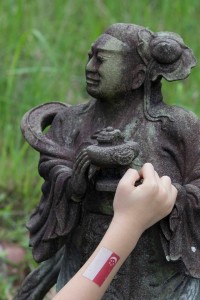
埋骨何須 故里 盖棺 便是吾盧 Why is it necessary to bury my bones in my ancestral land? The place where my coffin is sealed is my home Tan Ean Kiam, on his tomb at Bukit Brown(photo Philip Holden)

The Chinese Tour led by Walter Lim, had some Hongkong visitors, so Cantonese was also the lingua franca of the day (photo Victor Yue)
Behind the Scenes, A Team of Brownies Setting the Stage for Celebration
Celebrations!
National Anthem as recorded by Albert Ong
Not Just Singapore’s birthday but 3 Brownie Birthdays in August!

Left to right “Uncle Foo aka Garden Hill” 9 August, Simone Lee 10 August and Keng Kiat 11 August- HUAT AH! (photo Khoo Ee Hoon)
” Deeply reflective and moving National Day observance at Bukit Brown today, with graves already exhumed and half the site sectioned off for the road. There are some things that money can’t buy. A big thank you to Catherine Lim, Claire Leow and others!” Philip Holden.
A big shout out to those behind the scenes and catering:Brownies Victor Lim, Sugen, Mil Jonathan, Raymond, Ee Hoon, Peter, Steven, Mitch, Andrew and tombkeeper Lim Ah Chye. To Lee Kok of Asia Pac Publishers for contributing goodies to goody bags, National Heritage Board for the bags and National Library Board for commemorative books on Khoo Seok Wan.
On Saturday 5th October’13, newly minted Brownie Simone Lee, conducted her first guided walk with the theme “The Ladies of the Straits Settlements.” It was a tribute to the endurance, resilience and the strength of character of our women pioneers, who played a significant role in championing greater freedom and education for females in Singapore, with support from the forward thinking men of their times.
This is her report.
Stories of the Ladies of Straits Settlement by Simone Lee
Despite the rain, some 40 participants bravely trickled in for the tour. A majority of them were first-timers at Bukit Brown and it was good to see a good mix of men and ladies in the crowd for the all-ladies themed tour. And much to my comfort, a group of Brownies – who together with the participants formed a sea of umbrellas – were there to support me in my first guided walk.
The stories harked back to the days, when education was frowned upon for the ladies and their social freedom, restricted. But the ladies of the Straits Settlements did not lack character, and demonstrated both verve and spirit.
The first story told was one of bravery. During the Japanese war, Soh Koon Eng rushed home from a friend’s house when she heard the air-raid sirens. While shielding her mother and her infant niece under an altar table, she was exposed to the splinters of a bomb that hit her house. She was taken to Kandang Kerbau hospital where she passed away the same day. Such is the cruelty of war, that Miss Soh’s story reminds us to not to take for granted, the peace we enjoy today.
Madam Oon Tuan Cheng was left to look after 6 young children when she was widowed. She was to lose her only 2 sons to Sook Ching, followed by the death of her eldest daughter. Her story is one of grief and endurance in the face of tragedy
At the turn of the 19th century, higher education for Chinese girls was introduced in Singapore by social reformers such as Chia Hood Theam and Lim Boon Keng, who together with other forward thinking men of the times started the Singapore Chinese Girls School.
Among the pioneers who studied in SCGS, was Lee Choo Neo who went on to medical school to become Singapore’s first woman doctor. She also started the the Chinese Ladies’ Association of Malaya which supported education for girls and a shelter for vulnerable women.
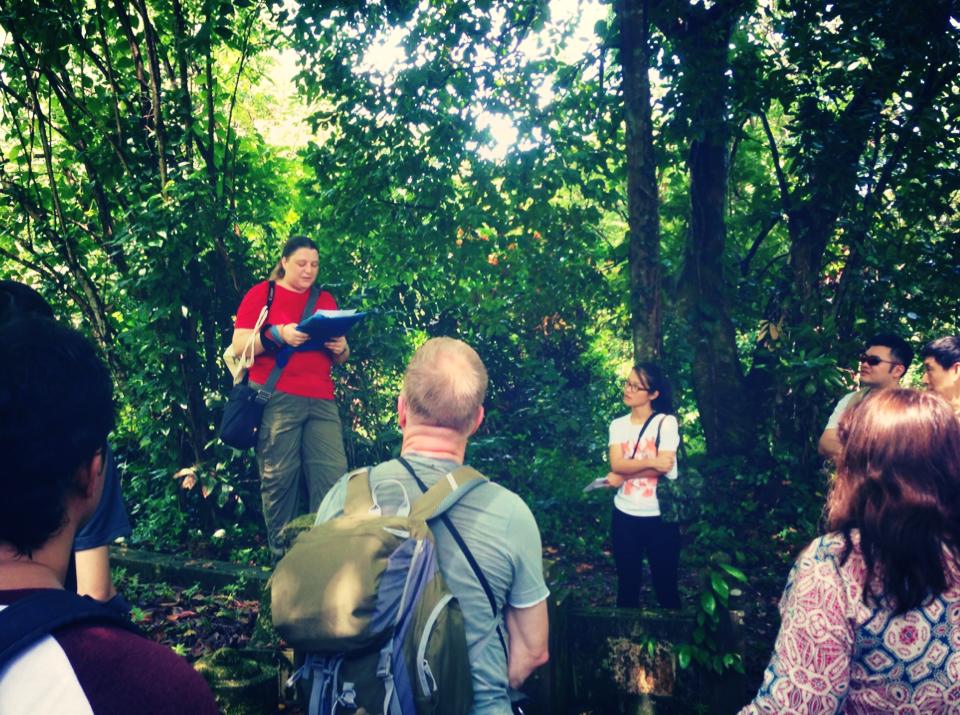
Bianca sharing the extraordinary achievements of Lee Choo Neo, Singapore’s first woman doctor (photo Theresa Teng)
Another SCGS alumni Madam Onn Chim Neo, also demonstrated that girls could excel in their studies and she encouraged efforts in improving the lives of Chinese ladies.
It is because of these pioneers that women today enjoy equality and freedom in many aspects of life, including social and physical activities. We no longer need to live our lives confined within the walls of our home.
By the end of walk, the skies had cleared, the sun came out, the air was filled with bird song and there were smiles and appreciation all round from the participants.
I had completed my first guided walk and felt that I learned more through guiding than in participating in tours.
A special thanks to all the Brownies who have mentored and supported me in various ways, from conceptualizing, planning and researching till the day of the actual tour.
It was Singapore’s 48th National Day and Bukit Brown’s 91st year. We sang the national anthem and recited the pledge with gusto and with pride. But when it came to observing a minute’s silence to honour the pioneers who are buried in Bukit Brown, there was a palpable sense of sadness. We remembered especially those whose graves are to be exhumed to make way for the highway..
James Tann captured this poignant moment as some 80 participants from the guided walks , stood shoulder to shoulder with the Brownies
And the celebrations continued with cake, supper and music in the air.
And there was music
Earlier, the participants had fanned out over all 5 hills on a 2 hour walk, as the Brownies shared stories from beyond the graves, of the trials and tribulations of the early pioneers. The Brownies who led the guided walks for NDP2013 :Many Stories, One Singapore@Bukit Brown were, Yik Han, Fabian, Catherine, Peter, Mil, Bianca and Claire.

The group which covered Hills 1 and 3 led by Brownie Mil Phuah took their group photo at her grandfather’s tomb cluster (Photo Mil Phuah)
One of the first groups to arrive were the heroes who completed the full walk starting from Kranji, through the rail corridor and ended at Bukit Brown for the guided walks. — at The National Day walk for a Greener Singapore: Former Rail Corridor-Central Catchment Area-Bukit Brown Cemetery.
As Claire led a guided walk over hills 5 and 2, . A.J. Leow, a participant reflected :
Somebody has to tell the next and this generation — Who came before us….We need more storytellers to tell our history
“Why 星汌 — when they first arrive (by sea), they see the shimmering lights — and they know it’s where the stars beckon. They have arrived in Singapore. 星汌 is our version of the Statue of Liberty, 星 加坡 seems a better choice than 新加坡. Think of 星汌 the lights of the shimmering harbor lights (stars) as they see Singapore for the first time” A.J. Leow
Darren Koh was moved to pen a tribute to the Brownies.
“On behalf of the how many thousands who have heard the many stories, the many histories, the many tales from the Brownies: I thank you. I thank you all for showing us a part of the warp and weft of history hidden to many of us. I thank you all for the passion that all of you have put, all that you have contributed whether by way of knowledge and research, by bush-bashing and discovery, by organisation and dissemination of information, by just being a friendly face that says hello, or just being there.
Were it not for the rise of the Brownies, the Tomb Whisperer and his brother alone would never have been able to reach out to so many.
It is said, “Cometh the hour, cometh the man.” In this instance, it was two women, and then many more – men and women who have joined in: one has gone ahead to her rest, but many still come.
All you Brownies – you earned that title. For your ceaseless search of tombs, for your ceaseless dissemination of the stories found. For the many tours you have led. For those moments when you look at greenery and cry a little wondering how, how could it be torn up – and then look into the eyes of those listening to your words about the pioneers and say “Let’s go to the next tomb..” Thank you”
From Theresa Teng: “What could be more meaningful than spending Singapore’s National Day in a place where pioneers of Singapore lay rested. A minute of silent was observed to commemorate the 4000+ tombs that will be sacrificed for a new highway, that will be build to cut right through Bukit Brown cemeteries.I’ve never been more proud of my adopted country than at this moment. Everyone united to stand for a cause. Mind you, there are plenty of foreigners in the group who cared so much about the heritage of Bukit Brown too.Hopefully, it’s still not too late for a miracle to happen. Just maybe…….”
From All Things Bukit Brown, in gratitude : Without the support and encouragement of the Heritage Singapore – Bukit Brown Community we would not have traveled so far. Thank you for walking shoulder to shoulder with us.
And last but not least, we end with a moving tribute to the 4,513 graves that will be exhumed at Bukit Brown. Matt Tan, penned the words in the Peranakan style of the pantun. Claire Leow translated with poetic license.
- “When stories are lost, the narrative is broken” (photo Victor Yue)
4,153 tempat tido akan di korek
ape yaukin di bikin
kehilangan cherita tak boleh di gantikan
4,153 in repose to be deposed
Why the urgency ?
When the stories are lost, the narrative is broken
霹雳五帮籍贯坟墓的造型与文化
李永球
霹靂州太平華聯中學初中三畢業,自中學開始對本邦歷史民俗 深感興趣,畢業後,一面協助父親小販事業,一面進行田野調查工作。並以李桃李、峇峇球等筆名,發表文章於報章雜志上。2004年成為全職的文史田野工作 者,足迹踏遍我国多个地方及国外多个国家。他也是《星洲日报·田野行脚》專欄作者。
本课题主要调查霹雳州太平、实兆远及怡保等地的华人坟墓,囊括福建、客家、广府、潮州及福州五帮籍贯之坟墓造型。霹雳州是个华人聚居的州属,早在十九世纪中叶,就有华人到来这里开采锡矿,并聚居于此。
边镇遗石:边佳兰义山与墓碑考察
莫家浩
2002年寬柔中學畢業,負笈中國大陸,先後畢業於廣州暨南大學與北京大學國際政治系,獲碩士學位。回國後,曾執教寬柔中學古來分校歷史科,現為業餘文史工作者。
邊加蘭在1830年代便有華人活動的記錄,卻異常缺乏文字記載。至今仍保存較為完整的義山群,早至1870年代的上千座墓碑,記錄了先民的籍貫、名字與宗族關係,為研究者提供了珍貴的一手資料。
English Introduction to the talks :
1) The Architecture and Culture of Tombs Belonging to the Five Dialect Groups in Perak
Lee Eng Kew
Eng Kew’s interest in local history and traditional customs manifested itself when he was in secondary school. After graduation, he helped out at his father’s hawker stall while pursuing his interests. In 2004, he became a full time researcher. He also writes a column for the Sin Chew Jit Poh.
This talk focuses on the architecture of tombs in Chinese cemeteries in Taiping, Ipoh and Sitiawan. The tombs examined belong to the Hokkien, Hakka, Cantonese, Teochew and Hock Chew styles.
2)A Study of the Chinese Cemetery and Tombstones in Pengarang
Bak Jia How
A graduate of Jinan University in Guangzhou, Jia How obtained his Masters in the School of International Studies in Beijing University. He was a history teacher in the Kulai branch of Foon Yew High School. He is currently a freelance historian.
Although there were Chinese settlers in Pengarang by the 1830s, historical texts make scant mention of them. In view of this, the old tombstones found in the cemeteries in the area are an invaluable resource for historical research on the chinese communities of Pengarang.
As part of Bukit Brown : Our Roots, Our Future, a series of talks were programmed to enrich the exhibition which was held at the Chui Huay Lim Club, the co-organiser of the exhibition.
Speaker Dr Imran bin Tajudeen gave insights into Singapura’s Historic Cemetery at Jalan Kubor which has royal roots. Several old settlements existed in Singapore besides the Temenggong’s estuarine settlement at Singapore River before Raffles’ arrival in 1819. Among these, Kampung Gelam and the Rochor and Kallang River banks were also sites of historic graveyards related to old settlements of Singapura both before and during colonial rule. The Jalan Kubor cemetery is the only sizable cemetery grounds still largely undisturbed. It belongs with Kampung Gelam history but has been excluded from the “Kampong Glam Conservation District” boundary, and is important for several reasons. It forms part of the old royal port town that was developed when Tengku Long of Riau was installed as Sultan Hussein in Singapore, and is aligned along the royal axis of the town. It is also the final resting place of several traders of diverse ethnicity from the old port towns of our region – neighbouring Riau, Palembang, and Pontianak, as well as Banjarmasin and the Javanese and Bugis ports further afield. Some of these individuals are buried in family enclosures, mausolea, or clusters. Conversely, there are also hundreds of graves of unnamed individuals from Kampung Gelam and surrounding areas. The tombstone forms and epigraphy reflect this immense socio-cultural diversity, and were carved in Kampung Gelam by Javanese and Chinese stone carvers, except for a number of special cases. Several large trees of great age are also found in this lush ‘pocket park’. The talk discusses the histories that can be retrieved from this important site and the dire need to protect it.
Speaker’s Bio
Dr Imran bin Tajudeen is an Assistant Professor at the Department of Architecture, NUS. His research interests centre around vernacular urbanism, house and mosque architecture in Southeast Asia, and critical perspectives in urban heritage studies. Of relevance to this talk is his article, ‘Reading the Traditional City in Maritime Southeast Asia: Reconstructing the 19th century Port Town at Gelam-Rochor-Kallang, Singapore,’ published in the Journal of Southeast Asian Architecture in 2005. His research papers have won prizes at major international conferences, including the ICAS Book Prize 2011 for the best PhD paper in the field of Social Sciences.
———————————————————————————————————
Part 1 and Part 2 of theEnglish talks from other speakers are also available.
Despite the the threatening clouds, some 50 people turned up for the special tour to Ong Sam Leong with guest participant, John Hunt, author of ” Struggling Through Strength.” On the way to the Ong’s family cluster, it drizzled but cleared for a while, when it came time for John to share his insights of the grime lives of the coolies, who worked on the phosphate mines on Christmas Island. He held his audience rapt with the minutiae of the harsh environment where fresh water was scarce and the diet meager. The coolies worked 9 hour days, six days a week and were often called upon to undertake “emergency” overtime when the ships called, and they had to quickly load up as many tons of phosphate. The mineral was in demand as it was used in the manufacture of fertilisers in the region.
Later in the afternoon, standing room at Select Books where John spoke further on what his research uncovered about life across the spectrum of classes on Christmas Island.
From participant James Tann : Last Saturday, I finally joined them on one of their free guided tours through Bukit Brown Cemetery.I would encourage anyone who has not been there to join one of their weekend tours. It would be an eye opener for many and you will feel the dedication, the enthusiasm and passion of the ‘Brownies’. I dedicate the following video that I made to them for all their efforts to preserve this part of our country’s heritage.
For more on the tour, the Rojak Librarian ‘s report here.
——————————————————————————————————–
Ong Sam Leong, made his fortune on Christmas island by recruiting “coolies” from Kwantung Province to work on the phosphate mines.
John Hunt, author of “Suffering Through Strength” – the story of Christmas Island (1899 – 1948) emphasizing the Chinese coolie experience – will be a guest participant and share some insights of their hardships at the Ong Sam Leong family cluster., where we will end our tour of Hill 3.
This tour is in support of a talk co-organised by the Singapore Heritage Society and Select Books by the author at 3pm the same afternoon at Select Books.
Tour Details:
Time : 9am -11.30 am
Meeting Place: Under the large and beautiful, and possibly endangered rain tree, at the Roundabout after the main gate on your left.
Bukit Brown. More than a cemetery. More than a Chinese cemetery. Come discover our heritage and history, while enjoying the habitat.How to get there and handy tips here: http://bukitbrown.com/
If you have a FB account, please click ‘Join’ on the FB event page to let us know you are coming, how many pax are turning up. Or just meet us at the starting point at 9am. Brownie Code: We guide rain or shine.
Don’t forget to bask in the peaceful surrounds, and also chat with your guides and make friends with other participants. We are amateurs and volunteers, but we are passionate and serious about what we do at Bukit Brown, and we encourage sharing of knowledge.Here is a map of the grounds:
http://bukitbrown.com/
From North: Go to Marymount MRT and walk to bus-stop #53019 along Upper Thomson Road. Take Buses 52, 74, 165, 852, 855
Alight 6 stops later at bus-stop, #41149, opposite Singapore Island Country Club (SICC), Adam Road. Walk towards Sime Road in the direction of Kheam Hock Road until you see Lorong Halwa.
From South: Go to Botanic Gardens MRT and walk to bus-stop #41121 at Adam Road, in front of Singapore Bible College. Take Buses 74, 93, 157, 165, 852, 855. Alight 2 stops later at bus-stop, #41141, just before Singapore Island Country Club (SICC), Adam Road. Cross the bridge, walk towards Sime Road, follow the road until you see Lorong Halwa.
By car:
Turn in from Lornie Road, to Sime Road. Then, turn left into Lorong Halwa.
Parking space available at the largish paved area near the cemetery gates.

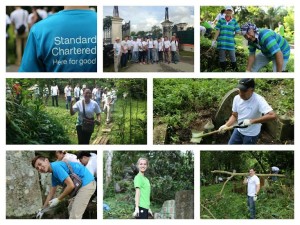

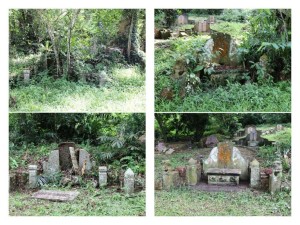





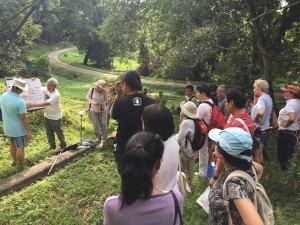


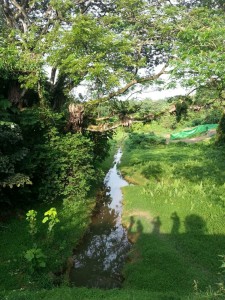







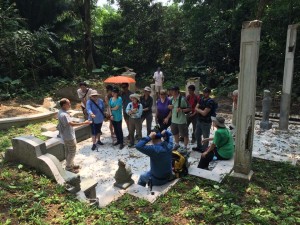















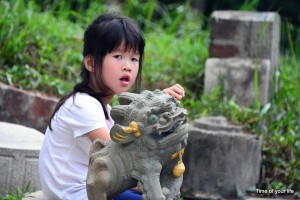

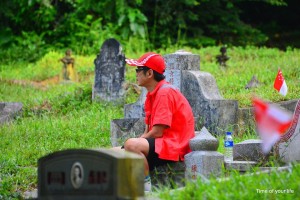


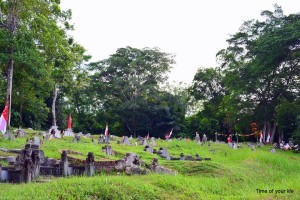













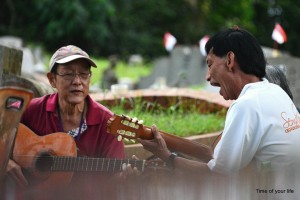

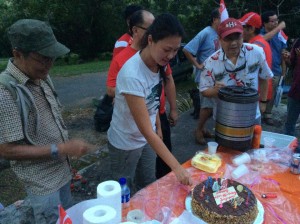








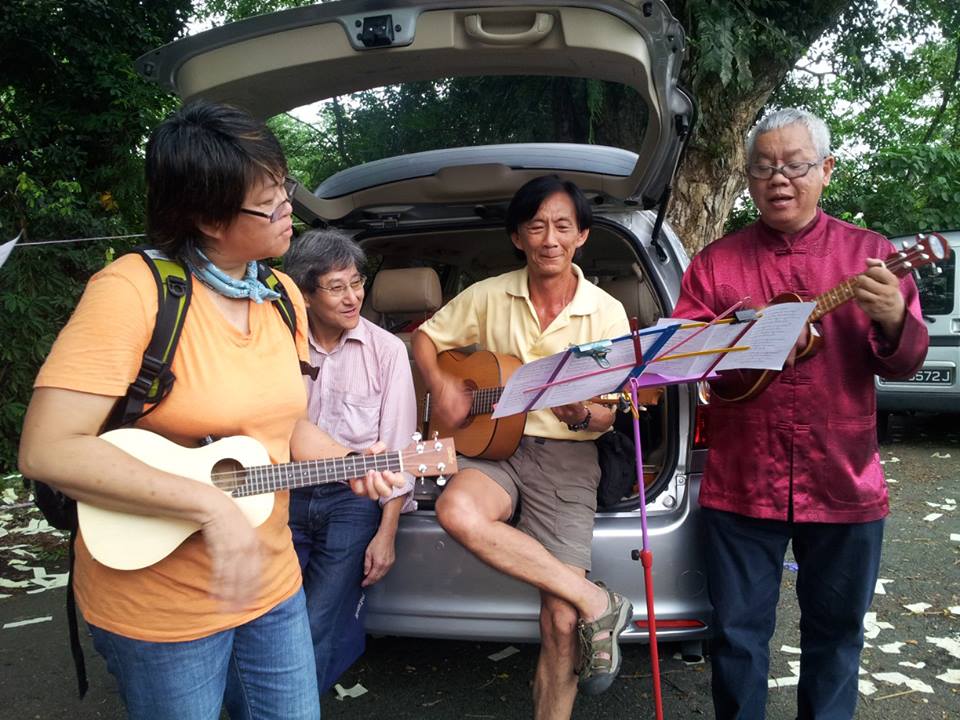







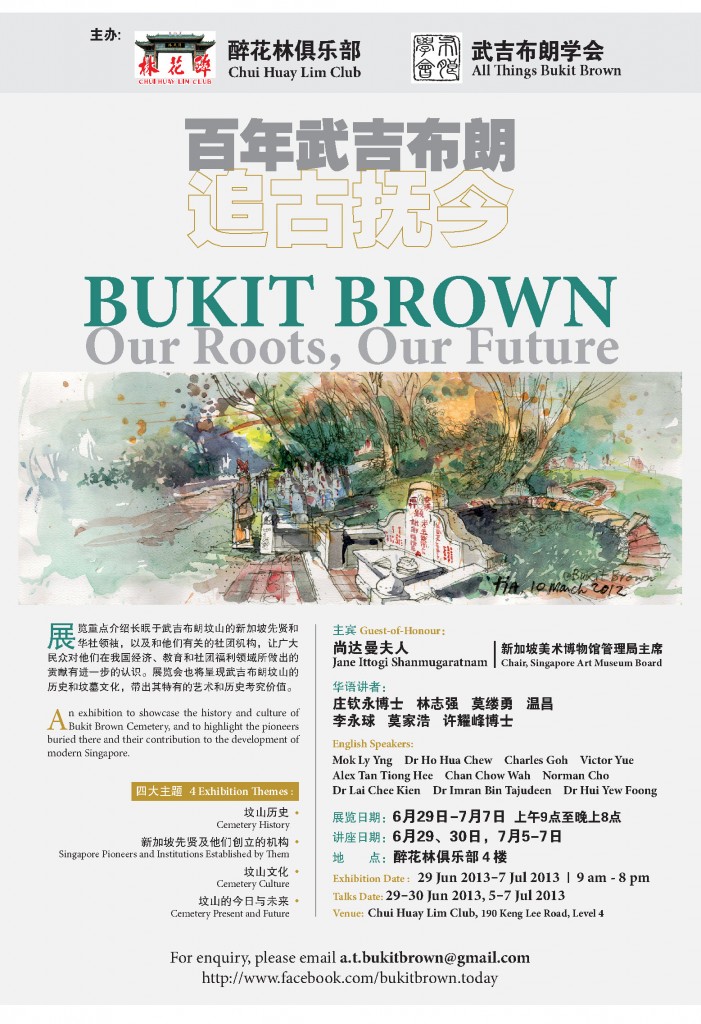
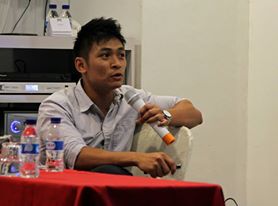




Recent Comments